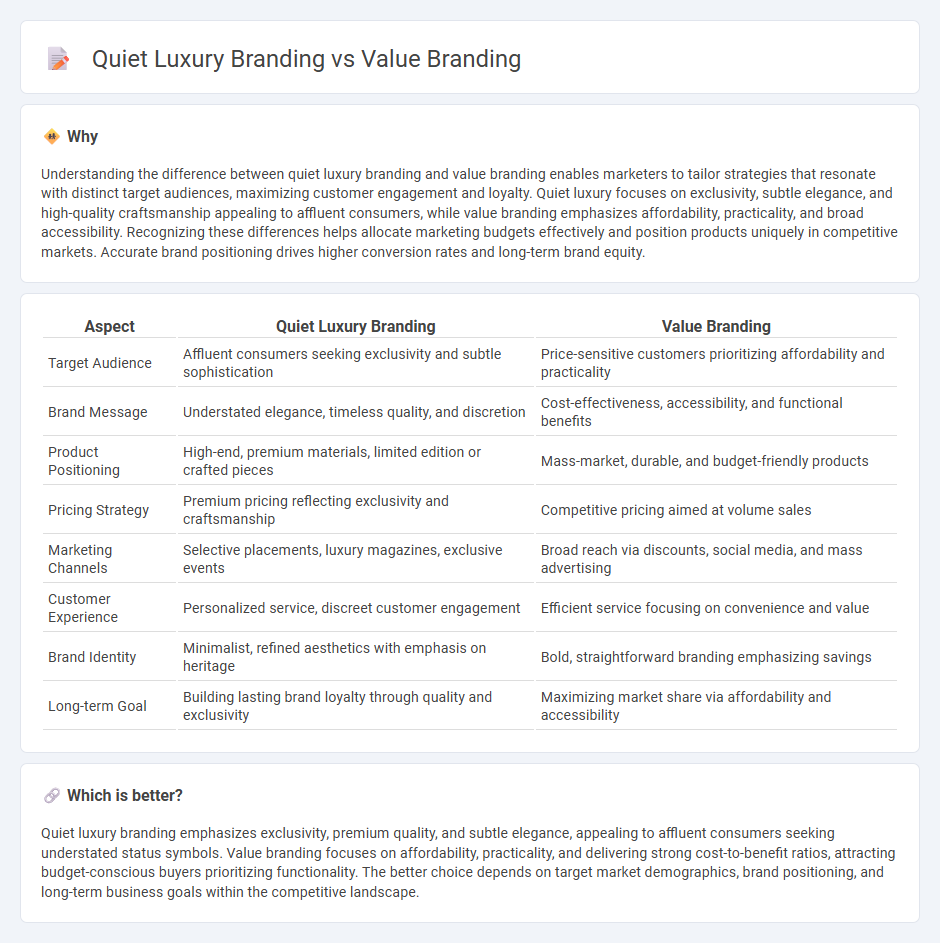
Quiet luxury branding emphasizes understated elegance, superior craftsmanship, and exclusivity, appealing to discerning consumers who prioritize quality over flashiness. Value branding focuses on affordability, practicality, and accessibility, targeting budget-conscious buyers seeking the best price-performance ratio. Explore how these contrasting strategies influence consumer behavior and market positioning to enhance your brand's impact.
Why it is important
Understanding the difference between quiet luxury branding and value branding enables marketers to tailor strategies that resonate with distinct target audiences, maximizing customer engagement and loyalty. Quiet luxury focuses on exclusivity, subtle elegance, and high-quality craftsmanship appealing to affluent consumers, while value branding emphasizes affordability, practicality, and broad accessibility. Recognizing these differences helps allocate marketing budgets effectively and position products uniquely in competitive markets. Accurate brand positioning drives higher conversion rates and long-term brand equity.
Comparison Table
| Aspect | Quiet Luxury Branding | Value Branding |
|---|---|---|
| Target Audience | Affluent consumers seeking exclusivity and subtle sophistication | Price-sensitive customers prioritizing affordability and practicality |
| Brand Message | Understated elegance, timeless quality, and discretion | Cost-effectiveness, accessibility, and functional benefits |
| Product Positioning | High-end, premium materials, limited edition or crafted pieces | Mass-market, durable, and budget-friendly products |
| Pricing Strategy | Premium pricing reflecting exclusivity and craftsmanship | Competitive pricing aimed at volume sales |
| Marketing Channels | Selective placements, luxury magazines, exclusive events | Broad reach via discounts, social media, and mass advertising |
| Customer Experience | Personalized service, discreet customer engagement | Efficient service focusing on convenience and value |
| Brand Identity | Minimalist, refined aesthetics with emphasis on heritage | Bold, straightforward branding emphasizing savings |
| Long-term Goal | Building lasting brand loyalty through quality and exclusivity | Maximizing market share via affordability and accessibility |
Which is better?
Quiet luxury branding emphasizes exclusivity, premium quality, and subtle elegance, appealing to affluent consumers seeking understated status symbols. Value branding focuses on affordability, practicality, and delivering strong cost-to-benefit ratios, attracting budget-conscious buyers prioritizing functionality. The better choice depends on target market demographics, brand positioning, and long-term business goals within the competitive landscape.
Connection
Quiet luxury branding emphasizes understated elegance and high-quality craftsmanship, appealing to discerning consumers seeking exclusivity without overt logos. Value branding focuses on delivering strong customer perceptions of quality and benefits relative to price, fostering brand loyalty and trust. Both strategies connect by targeting sophisticated market segments that prioritize intrinsic value and authenticity over flashy marketing.
Key Terms
Price Perception
Value branding emphasizes affordability and cost-effectiveness, targeting price-sensitive consumers who seek practical benefits and good quality for their money. Quiet luxury branding cultivates an image of exclusivity and subtle sophistication, often commanding higher price perceptions through understated design, premium materials, and scarcity. Explore deeper insights on how price perception shapes consumer behavior in these distinct branding strategies.
Brand Image
Value branding emphasizes affordability and accessibility, often highlighting functionality and cost-effectiveness to appeal to budget-conscious consumers. Quiet luxury branding centers on understated elegance, exclusivity, and superior craftsmanship, fostering a sophisticated and timeless brand image without overt logos or flashy marketing. Explore how these distinct strategies shape consumer perception and loyalty to better understand their impact on brand image.
Exclusivity
Value branding emphasizes affordability and broad appeal while maintaining a perception of quality, targeting cost-conscious consumers seeking accessible luxury. Quiet luxury branding prioritizes exclusivity through subtle sophistication, minimal logos, and high craftsmanship, attracting affluent customers who prefer discretion over overt status symbols. Explore how these distinct branding strategies impact consumer perception and market positioning.
Source and External Links
Brand Values: Definition, Examples & How to Define Them - Brand values are the fundamental beliefs that guide a company's operations and help establish a strong brand identity, differentiate from competitors, and build trust with customers by aligning with their values.
What Are Brand Values? Definition, Examples and Why They Matter - Brand values are a set of beliefs presented to customers that influence leadership, organizational culture, and customer connection, with common examples including integrity, innovation, and sustainability.
What Are Brand Values? A Definition and Complete Guide (2024) - Brand values are the key principles that define how a company operates and fulfills its mission, affecting sourcing, delivery, and employee treatment, and are crucial in today's consumer purchasing decisions.
 dowidth.com
dowidth.com